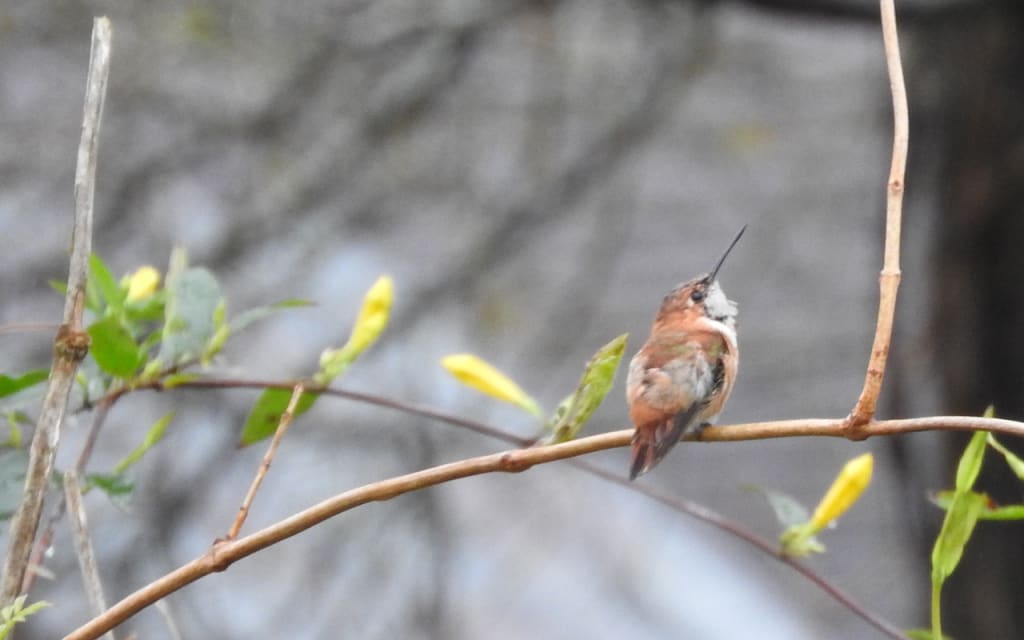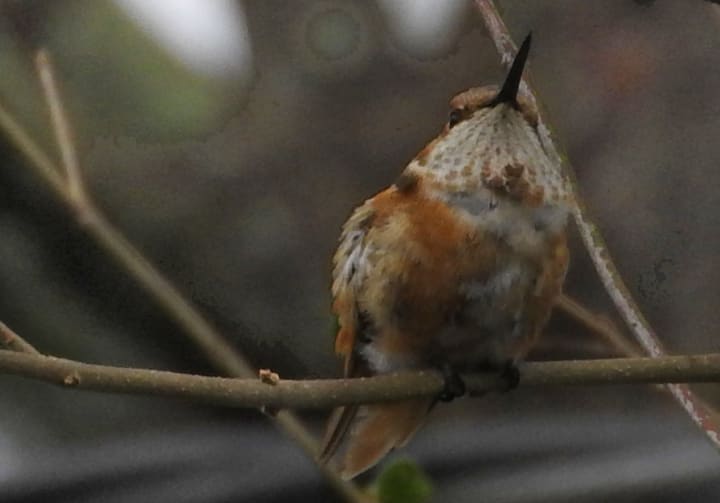We See More Rufous Hummingbirds Than Ever While Their Population Is Crashing
The passenger pigeon dilemma

What happens when a common bird seems to be everywhere-- and yet the cold hard census numbers show that its population keeps spiraling down? Will we act in time to save that bird? Or will we trick ourselves into waiting until it's too late?
There’s a lot to unpack in a new Open Access article on Nature about current North American hummingbird population trends. In the way of serious scientific articles, the citation is quite long, so I’ve posted it at the end so you can read it for yourself. In brief, the news is not good for some of our most popular garden birds — including the feisty and much-beloved Rufous Hummingbird.
As I machete my way through the thicket of statistics, I encounter heart-chilling nuggets like this:
“From 1970 to 2019, rufous hummingbird net population change was −65%… and this rate of decline has also accelerated…”
And this:
“Allen’s, Rufous, and broad-tailed hummingbird declines have all accelerated over the last three generations to nearly double the rate of decline over the previous half-century. “
We’re losing them.
***
How can it be? Oh, the researchers understand we’re going to find it hard to accept this news. They invest much time and care in documenting their numbers.
And yet it still seems so surreal.
When I was a child, I could go an entire winter and never see a single one. Now I put up my feeders with confidence, knowing they will come.
On the Gulf Coast, Rufous Hummingbirds are an expected pollinator in our winter gardens. The photos in this story were grabbed easily enough from my home office window. They’re the entire reason some people bother to put up winter feeders at all.
Many bold birds venture even farther to the east. Back in the 1980s, people assumed these birds were lost. I seem to recall a lady up north who wrote a whole book about how she captured winter hummingbirds so she could ship them back west from whence they came.
Maybe don’t do that.

As recently as the early 21st-century, people were still sharing this myth. For example, a Rock Hill, South Carolina woman who hosted a first-year Rufous Hummingbird over the winter of 2003/2004 named her visitor Perdita (“Lost”) because of the stories she was told about how her young bird must have wandered from its path.
Then the banded bird returned to her yard the next winter. And the next. As the banders wrote after recapturing and documenting the bird in 2005:
“[W]e’re personally beginning to think she’s not “lost” in the first place… Rufous Hummingbirds in winter in the Carolinas aren’t a new phenomenon — there are occasional records going back to the very early 1900s — but only in the past decade or two have we seen an explosion of winter vagrant hummingbird species in the eastern U.S…”
The same story — with a lot more Rufous Hummingbirds — is true of the Gulf Coast. We didn’t use to think much about west to east migration, but it was probably always happening. And now we see it happening even more.
Winter after winter, they return. And others like them. More and more of them. Why, they’re positively booming!
Or so it seems from this end of their migration.
Alas. As we know from the sad story of the Passenger Pigeon, you can see a lot of birds up until almost the last few moments before they vanish forever.
***
The Open Access Nature Briefing goes on to say this:
“On the wintering grounds, the rufous hummingbird has reportedly experienced an expansion of wintering distribution, perhaps attributable to an increase in resources provided in gardens and genetic reprogramming of migratory orientation. The authors acknowledge the potential for observer biases, wherein more resources for identification of rufous hummingbirds promotes more frequent reporting as well as an unknown increase in supplemental resource provisioning.”
In other words, we Gulf Coasters aren't imagining things. We’re indeed seeing more birds in our winter gardens.
Not because there are more of them but because we’ve learned how to spot them better. If a Gulf Coast gardener saw a hummingbird in their December flowers in 1975, they probably thought the bird was a Ruby-throat who failed to migrate, and they didn’t take a second glance. It’s hard to see when you’re not looking.
It also doesn’t hurt that nowadays we plant more food and set up more feeders for them, so they’re more visible close to home. These days, it’s fairly unusual for me to talk to someone who takes down their hummingbird feeder for the winter — a practice that used to be the norm.
So there’s where the illusion of abundance comes from. We see more than we used to see because 1) we’ve learned to look, and 2) we’re using the right food to draw them closer. So far, we’ve been doing enough of this stuff fast enough to give us the impression they’re doing well.
And, in truth, the Rufous Hummingbirds who make it to our yards year after year probably are doing well. It’s the birds we don’t see who are in trouble.
Reprogramming of migratory orientation is a concept I have to meditate on. I think it means we’ve always had a few birds genetically programmed to migrate west to east instead of north to south. Over time, as the wintering areas in Mexico are logged, those birds who migrate east have a better chance of survival than those who migrate south. Therefore we who live in the east, especially on the Gulf Coast, see more of them than we used to.
So that could be a third reason we Gulf Coasters think they’re more abundant. There are more in our area.
Still, the cold hard numbers say we don’t really have more Rufous Hummingbirds worldwide. We have a local illusion of more Rufous Hummingbirds.
For now anyway.
Illusions have a way of collapsing.
***
Author's Note: This story was previously published in Gardening, Birding, and Outdoor Adventure, a publication located on the Medium platform. To let me you know you read and enjoyed it on Vocal, please gently tap the <3 button below. Tips are gratefully accepted.
Citation: English, S.G., Bishop, C.A., Wilson, S. et al. Current contrasting population trends among North American hummingbirds. Sci Rep 11, 18369 (2021). I strongly encourage you to read the entire paper, which may be found here.
If you enjoyed this story, you may also enjoy this one: Blue-throated Macaws: A Rediscovered Species, which includes a personal encounter with the critically endangered Blue-throated Macaw in Beni, Bolivia.
About the Creator
Amethyst Qu
Seeker, traveler, birder, crystal collector, photographer. I sometimes visit the mysterious side of life. Author of "The Moldavite Message" and "Crystal Magick, Meditation, and Manifestation."
https://linktr.ee/amethystqu






Comments
There are no comments for this story
Be the first to respond and start the conversation.